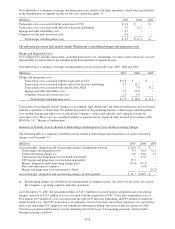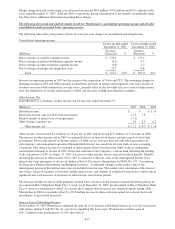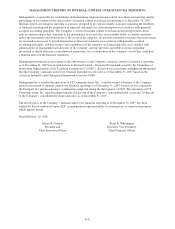Windstream 2007 Annual Report Download - page 111
Download and view the complete annual report
Please find page 111 of the 2007 Windstream annual report below. You can navigate through the pages in the report by either clicking on the pages listed below, or by using the keyword search tool below to find specific information within the annual report.
selected as of December 31, 2007 for financial reporting purposes for the qualified pension plan reflected the impact of
the Act. The Act has not had a significant accounting impact nor has it triggered a significant event for the qualified
pension plan. Furthermore, based on a future funding analysis prepared in June 2007, the qualified pension plan is
expected to be adequately funded for the next three to five years such that plan contributions are not likely to be
required under the Act. However, future contributions to the plan are dependent on various factors, including future
investment performance, changes in future discount rates and changes in the demographics of the population
participating in the qualified pension plan.
We calculated our annual postretirement expense for 2008 based upon a number of actuarial assumptions, including a
healthcare cost trend rate of 9.00 percent and a discount rate of 6.38 percent. Consistent with the methodology used to
determine the appropriate discount rate for the Company’s pension obligations, the discount rate selected for
postretirement benefits is based on a hypothetical portfolio of high quality bonds with maturities that mirrored the
expected payment stream of the benefit obligation. The discount rate determined on this basis increased from 5.90
percent at December 31, 2006 to 6.38 percent at December 31, 2007. Lowering the discount rate by 25 basis points
(from 6.38 percent to 6.13 percent) would result in an increase in postretirement expense of approximately $0.3 million
in 2008.
The healthcare cost trend rate is based on our actual medical claims experience and future projections of medical costs.
For the year ended December 31, 2008, a one percent increase in the assumed healthcare cost trend rate would increase
our postretirement benefit cost by approximately $1.1 million, while a one percent decrease in the rate would reduce
our allocation of postretirement benefit cost by approximately $1.0 million.
See Notes 2 and 8 for additional information on Windstream’s pension and other postretirement plans.
Useful Lives of Assets – The calculation of depreciation and amortization expense is based on the estimated economic
useful lives of the underlying property, plant and equipment and finite-lived intangible assets. As discussed in Note 2,
the Company reduced the depreciation rates on property, plant and equipment used in its operating markets based on
studies completed between 2005 and 2007 of the related lives of those assets. Although we believe it is unlikely that
any further significant changes to the useful lives of our finite-lived intangible assets will occur in the near term, rapid
changes in technology or changes in market conditions could result in revisions to such estimates that could materially
affect the carrying value of these assets and our future consolidated operating results. The Company expects to realize
reductions in its depreciation expense in 2008, which is the first full year following the completion of the rate studies.
Decreases in depreciation expense have already been realized in markets whose studies were completed.
Goodwill and Other Indefinite-lived Intangibles – In accordance with SFAS No. 142, “Goodwill and Other Intangible
Assets”, we test our goodwill for impairment at least annually, or whenever indicators of impairment arise. SFAS
No. 142 requires write-downs of goodwill only in periods in which the recorded amount of goodwill exceeds the fair
value. The fair value of goodwill is determined by estimating the fair value of the reporting units to which it has been
assigned. The fair value of a reporting unit is calculated utilizing a combination of the discounted cash flows of the
reporting unit and the calculated market values of comparable companies. If the fair value of the reporting unit is less
than its carrying value, a second calculation is required in which the implied fair value of goodwill is compared to its
carrying value. If the implied fair value of goodwill is less than its carrying value, goodwill must be written down to its
implied fair value.
SFAS No. 142 requires that we evaluate the remaining useful lives of our other indefinite-lived intangible assets and
test them for impairment at least annually, or more frequently if events or changes in circumstances indicate that the
asset may be impaired. If the carrying value of an indefinite-lived intangible asset exceeds its fair value, an impairment
loss is recognized in an amount equal to the excess. Windstream determines the fair value of its indefinite-lived
intangible assets using a combination of cost-based and income-based approaches.
The Company performs its impairment analysis on January 1st of each year. During 2007 and 2006, no write-downs in
the carrying values of either goodwill or indefinite-lived intangible assets were required based on their calculated fair
values. In addition, reducing the calculated fair values of goodwill by 10 percent, and the wireline franchise rights by 5
percent, would not have resulted in an impairment of the carrying value of the related assets in either year. Changes in
the key assumptions used in the discounted cash flow analysis due to changes in market conditions could adversely
affect the calculated fair values of goodwill and other indefinite-lived intangible assets, materially affecting the
carrying value of these assets and our future consolidated operating results.
As a result of the sale of the publishing business, Windstream agreed to forego future royalty payments from the
directory publishing business on advertising revenues generated from its directories. As these royalties were included
F-25
























